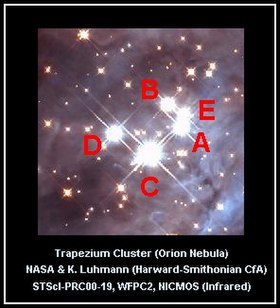Theta1 Orionis D
Appearance
(Redirected from Θ1 Orionis D)
| Observation data Epoch J2000 Equinox J2000 | |
|---|---|
| Constellation | Orion |
| Right ascension | 05h 35m 17.24645s[1] |
| Declination | −05° 23′ 16.5707″[1] |
| Apparent magnitude (V) | 6.70[2] |
| Characteristics | |
| Spectral type | B1.5 Vp[3] |
| U−B color index | −0.71[2] |
| B−V color index | +0.09[2] |
| Astrometry | |
| Radial velocity (Rv) | +32.4[4] km/s |
| Proper motion (μ) | RA: +1.822[1] mas/yr Dec.: _0.393[1] mas/yr |
| Parallax (π) | 2.2820 ± 0.0207 mas[1] |
| Distance | 1,430 ± 10 ly (438 ± 4 pc) |
| Absolute magnitude (MV) | −3.3[5] |
| Details | |
| Mass | 18±6[5] M☉ |
| Radius | 5.6±0.8[5] R☉ |
| Luminosity | 29,500[5] L☉ |
| Surface gravity (log g) | 4.2±0.1[5] cgs |
| Temperature | 32,000±1,000[5] K |
| Rotational velocity (v sin i) | 49.0±0.9[5] km/s |
| Age | 2.5±0.5[5] Myr |
| Other designations | |
| Database references | |
| SIMBAD | data |
Theta1 Orionis D (θ1 Orionis D) is a member of the Trapezium open cluster that lies within the Orion Nebula. It is a B class blue main sequence star with several faint companions.
θ1 Orionis consists of multiple components, primarily the four stars of the Trapezium cluster (A, B, C, and D) all within one arc-minute of each other. θ2 Orionis is a more distant grouping of three main stars plus several fainter companions, 1-2 arc-minutes from θ1.
θ1 D itself has a faint optical companion 1.4" away and a spectroscopic companion in a 40-day orbit. Infrared Optical Telescope Array observations suggest another companion at 18.6 mas.[6]
References
[edit]- ^ a b c d e Vallenari, A.; et al. (Gaia collaboration) (2023). "Gaia Data Release 3. Summary of the content and survey properties". Astronomy and Astrophysics. 674: A1. arXiv:2208.00211. Bibcode:2023A&A...674A...1G. doi:10.1051/0004-6361/202243940. S2CID 244398875. Gaia DR3 record for this source at VizieR.
- ^ a b c Ducati, J. R. (2002). "VizieR Online Data Catalog: Catalogue of Stellar Photometry in Johnson's 11-color system". CDS/ADC Collection of Electronic Catalogues. 2237: 0. Bibcode:2002yCat.2237....0D.
- ^ Levenhagen, R. S.; Leister, N. V. (2006). "Spectroscopic analysis of southern B and Be stars". Monthly Notices of the Royal Astronomical Society. 371 (1): 252–262. arXiv:astro-ph/0606149. Bibcode:2006MNRAS.371..252L. doi:10.1111/j.1365-2966.2006.10655.x. S2CID 16492030.
- ^ Olivares, J.; Sánchez, L. J.; Ruelas-Mayorga, A.; Allen, C.; Costero, R.; Poveda, A. (2013). "Kinematics of the Orion Trapezium Based on Diffracto-Astrometry and Historical Data". The Astronomical Journal. 146 (5): 106. arXiv:1310.0769. Bibcode:2013AJ....146..106O. doi:10.1088/0004-6256/146/5/106. S2CID 119110490.
- ^ a b c d e f g h Simón-Díaz, S.; Herrero, A.; Esteban, C.; Najarro, F. (2006). "Detailed spectroscopic analysis of the Trapezium cluster stars inside the Orion nebula". Astronomy and Astrophysics. 448 (1): 351–366. arXiv:astro-ph/0510288. Bibcode:2006A&A...448..351S. doi:10.1051/0004-6361:20053066. ISSN 0004-6361. S2CID 16445304.
- ^ Grellmann, R.; Preibisch, T.; Ratzka, T.; Kraus, S.; Helminiak, K. G.; Zinnecker, H. (2013). "The multiplicity of massive stars in the Orion Nebula Cluster as seen with long-baseline interferometry". Astronomy & Astrophysics. 550: A82. arXiv:1301.3045. Bibcode:2013A&A...550A..82G. doi:10.1051/0004-6361/201220192. S2CID 6554786.

